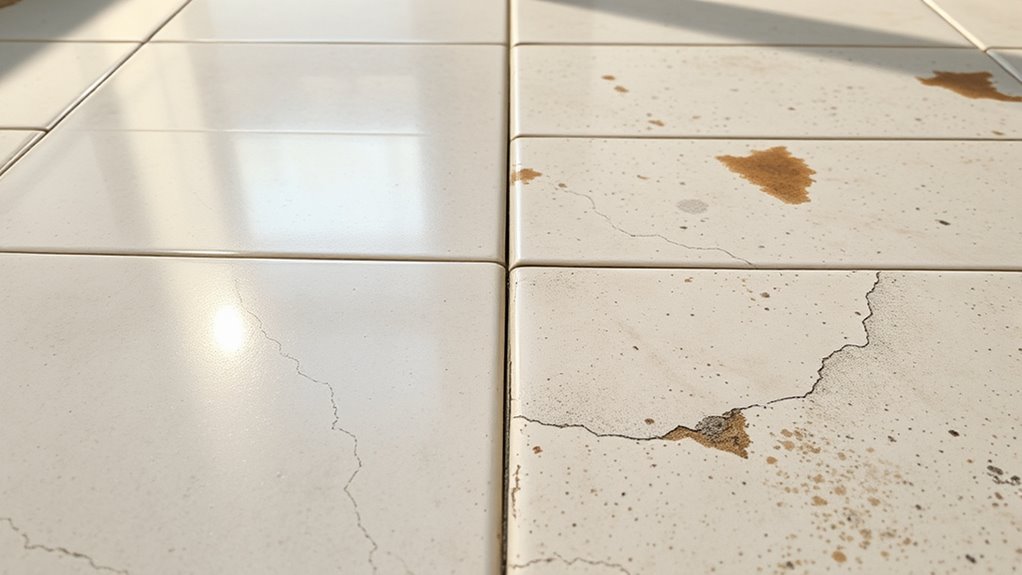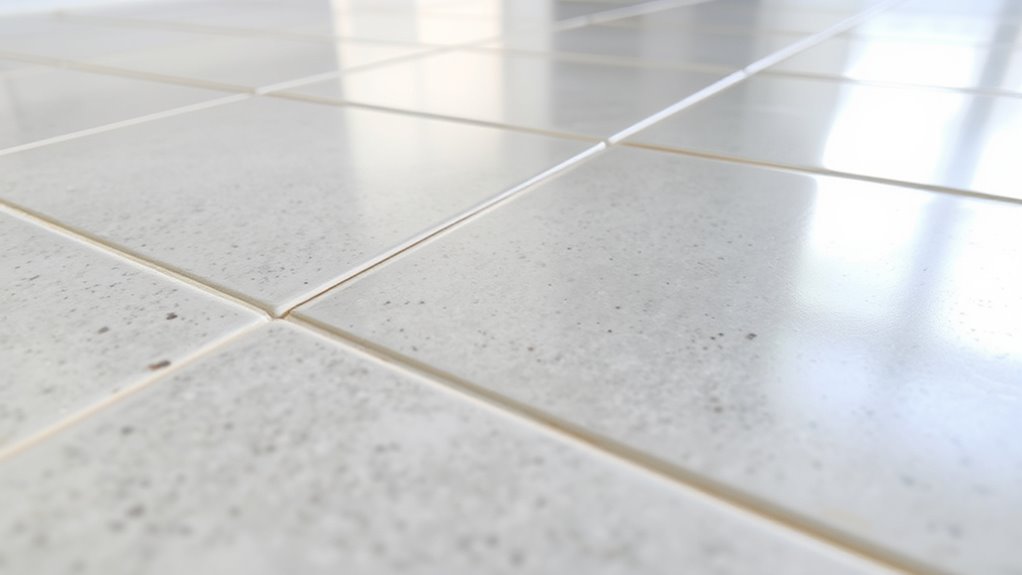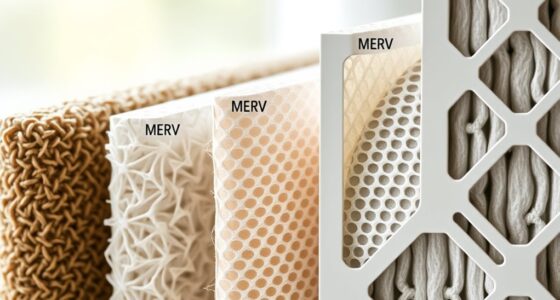Skipping grout sealing may save you a little time and money upfront, but it can lead to costly problems later. Without a proper seal, moisture, dirt, and stains seep into the grout, causing discoloration, mold, and deterioration. This increases your maintenance needs and shortens the lifespan of your tiles. Regular sealing can prevent these issues and save you money over time. If you want to understand how it all works, keep exploring the benefits of proper grout care.
Key Takeaways
- Skipping grout sealing allows stains and mold to penetrate, leading to costly cleaning and repairs later.
- Unsealed grout is more prone to discoloration and deterioration, shortening its lifespan and increasing replacement costs.
- Without sealing, moisture and dirt can infiltrate, causing structural damage and promoting mold growth.
- Neglecting sealing results in frequent, intensive cleaning and maintenance to preserve tile appearance.
- Proper sealing extends grout durability, saving money by preventing early degradation and the need for premature regrouting.

Are you tired of stubborn stains and mold growing in the grout between your tiles? It’s a common frustration, but the solution might be simpler than you think. Properly sealing your grout isn’t just about keeping it clean; it’s about protecting your investment and preventing costly repairs down the line. One of the first things you should consider is grout color options. Choosing the right grout color can make a significant difference in how your tiled space looks and how well it resists staining. Lighter shades tend to show dirt and stains more easily, meaning you’ll need to clean and reseal more often. Darker colors, on the other hand, hide imperfections and stains better, which can extend the time between sealing. When selecting your grout color, keep in mind that it should complement your tiles and the overall aesthetic of your space, but also consider how it will stand up to daily wear and tear. Additionally, selecting a quality sealer can greatly enhance the durability and stain resistance of your grout over time. Sealing frequency tips are just as essential as choosing the right grout color. Many homeowners overlook this aspect, but consistent sealing can double or even triple the lifespan of your grout. Typically, you should reseal your grout every 1 to 2 years, but this can vary depending on your household activity and the type of sealer used. If you notice water no longer beads on the surface or if stains start to seep in, it’s time to reseal. Regular resealing acts as a barrier, preventing moisture and dirt from penetrating the porous grout and causing discoloration or mold growth. Skipping this important step might seem like a time-saver, but it often leads to bigger headaches later, such as removing stubborn stains or replacing entire sections of grout.
Frequently Asked Questions
How Often Should Grout Sealing Be Reapplied?
You should reseal your grout every 1 to 2 years, depending on the grout sealing frequency and the wear it endures. Regular resealing helps protect against stains and moisture damage, extending the life of your tiles. Keep an eye on your grout’s appearance and water absorption to determine when to follow your resealing schedule. Skipping or delaying resealing can lead to costly repairs down the line.
Can Grout Sealing Be Done DIY?
You can definitely attempt DIY grout sealing, but be aware of the challenges. Properly applying sealing products requires careful cleaning and precise application to avoid uneven coverage or missed spots. DIY challenges include choosing the right sealing products and ensuring the grout is completely dry beforehand. If you rush or don’t prep properly, you risk compromising the seal, which could lead to costly repairs down the line.
Is Grout Sealing Necessary for All Tile Types?
Think of grout sealing as armor for your tiles, a shield against stains and moisture. You might wonder if it’s needed for all tile types; the answer is no. Some grout color options and sealing product types work better on certain materials. Skipping sealing on porous tiles can lead to costly damage later, so choose the right sealing product types for your specific tile to keep your surface looking pristine.
What Are the Signs of Grout Deterioration?
You’ll notice signs of grout deterioration when the grout color changes, turning dull or stained, indicating wear. Mold growth is another sign, especially in moist areas, showing dark spots or a musty smell. These issues suggest your grout is breaking down and needs attention. Ignoring these signs can lead to bigger problems, like water damage or costly repairs, highlighting why regular maintenance and sealing are essential to keep your tiles in good shape.
How Long Does Grout Sealing Typically Last?
You’re probably wondering how long grout sealing lasts. Typically, sealing longevity ranges from 1 to 5 years, depending on usage and product quality. To keep your tile looking its best, you should follow a regular maintenance schedule and reseal when needed. Skipping resealing shortens the lifespan of your grout, leading to stains and damage that cost more to fix later. Stay proactive to protect your investment!
Conclusion
Skipping tile grout sealing might seem like a small detail now, but it can cost you big time later. Without it, stains and moisture can sneak in and cause damage that’s tough to fix. Think of it as putting off a small leak—eventually, it’ll turn into a flood. Protect your investment by sealing your grout today, so you don’t end up paying the price for neglect tomorrow. It’s better to be safe than sorry, after all.









